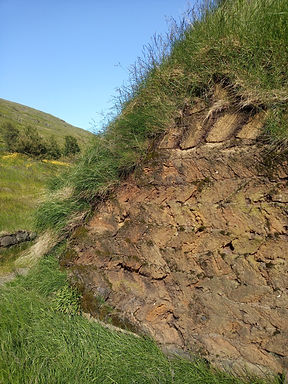Excavating and Reconstructing a 10th Century Farm


The original farm at Eiríksstaðir seems to have been abandoned when Eirík and his family left in the middle of the 10th century, leaving the longhouse, barn and outbuilding(s) to fall to ruins. Luckily for us, this means that we are able to interpret the archaeology they left behind and get a snapshot of what life was like for the family.
The first scholar to record the site was a man named Brynjúlfur Jónsson all the way back in 1894, with Þorsteinn Erlingsson excavating part of the ruins a year later. Incredibly, it seems that back then, the barn (now completely lost) was still clearly visible without any digging.
These first investigators didn't have the knowledge or technology to do a very good job of excavating by modern standards, but the excavations in 1938 and 1997–2002 were much more useful. We now know that there were at least two buildings on the farm - not including the barn - dating to between 850 and 1000CE. One was a small longhouse for the people to live, and the other was a sunken pit house which was probably used as a women's space to weave, spin and bathe. It is certainly possible that there were more buildings on the site, and also the midden (the rubbish pile) has yet to be found. Perhaps we will know even more about what the site looked like in the future!
Not a lot of objects were found inside the houses, just a few nails, loom weights, whetstones, and a broken spindle whorl. But even these show us what kind of work was done on the farm, such as making their own fabric from wool and plant fibres, and honing their farming tools. One interesting find was remains from refining iron, which could tell us that they produced their own metal from the deposits in the valley. The land itself looked very different back then, with the area of Eiríksstaðir being covered by birch trees, providing the people with building material and fuel for fires.
The farmhouse replica was built through a local initiative with assistance from an advisory committee of archaeologists from the National Museum. The current building is based on research about the oldest known structures of this type from Iceland and neighbouring countries of the same period. All the timber used in the building is driftwood.
The house was built using recreated Settlement Age tools which were reconstructed using archaeological finds and experimental archaeological techniques. The carvings and decorations are based on models from the same period. Paneling is used for the interior, and on top of the ceiling rafters, there is a layer of twigs and smaller branches, which is covered by three layers of turf to form the roof. The turf walls are layered as follows: One row of diagonally laid turf sods, followed by one row of thin sods, creating a sort of ribbon, then the next layer diagonally in the opposite direction, and so on. This method is called Klambra og Strengur.
Read more:
Archaeological research report from 1998
